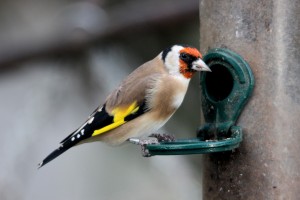 Just as some wild flowers are intriguing and mysterious, as mentioned in last week’s column, so are birds. One of these is now a common garden bird especially as they come after the tiny nyger seed, along with siskins, and it is many peoples favourite – the goldfinch. Even as I write there is a nyjer feeder only about six feet from my study window and it is a mass of squabbling adult and juvenile goldfinches and siskins. Both these birds seemed to have had a good season with the siskins bringing off a second brood which is always an indication the food has been plentiful. Historically the goldfinch played an important part in the formation of the RSPB as it was one of the birds taken up by The Society for the Protection of Birds that later became the RSPB. The reason for the involvement with goldfinches were the sheer numbers being taken as cage birds. For one county, Sussex, it was estimated that 132,00 birds were taken for cages each year. The other bird was the great crested grebe that were killed to use their skins as muffs!
Just as some wild flowers are intriguing and mysterious, as mentioned in last week’s column, so are birds. One of these is now a common garden bird especially as they come after the tiny nyger seed, along with siskins, and it is many peoples favourite – the goldfinch. Even as I write there is a nyjer feeder only about six feet from my study window and it is a mass of squabbling adult and juvenile goldfinches and siskins. Both these birds seemed to have had a good season with the siskins bringing off a second brood which is always an indication the food has been plentiful. Historically the goldfinch played an important part in the formation of the RSPB as it was one of the birds taken up by The Society for the Protection of Birds that later became the RSPB. The reason for the involvement with goldfinches were the sheer numbers being taken as cage birds. For one county, Sussex, it was estimated that 132,00 birds were taken for cages each year. The other bird was the great crested grebe that were killed to use their skins as muffs!
Goldfinches were associated with people who were wealthy meaning the gold in the name of the bird. This reference to wealth was also found in the popular rhyme “The marriage of Cock Robin and Jenny Wren”. In the nineteenth century version there are lines “Who gives this maid away? / I do says the goldfinch / And her fortune I will pay”. At one time there was also the belief that the goldfinches were healing birds. There was also believed to be a link between the goldfinch and Jesus – that its red face is a consequence of trying to remove the crucified Christ’s crown of thorns – and perhaps it is an icon of healing because it can feed on thistle and teasel seeds without hurting itself on the spines of these plants. At one time it was even believed that you could cure many ills by just looking at a goldfinch.
With such an attractive and popular bird it is not surprising that there are so many local names, Scots names and Gaelic names. Scot names number over ten and one interesting one is Sweet William. This is taken from the name Stinking billy after the “butcher” of Cumberland of Culloden. Other Scots name include Gooldie, Gowdie, Thistle finch, Thistle Warp and Goldspink. The Gaelic name is Deargan-fraoich which means Red stained one of the heather. After such a turbulent past the future of the goldfinch has never looked better as more and more people are not only feeding birds in the garden in the winter months but also in the summer.
Goldfinches like small seeds and having seen photographs of them on teasels I decided to grow some. The added bonus would be that butterflies also like the nectar in teasel flowers so they would take this in summer and the goldfinches the seeds in winter. The problem was that nobody told the goldfinches in the Highlands. Down south the teasel is widespread and the seeds freely taken by the goldfinches. Up here the only teasels are in gardens or are escapes so the goldfinches did not recognise the food source and just left them alone. The goldfinch in the photograph was taken in the garden at a feeder. The bird is ringed on its right leg and ringing helps us to understand various aspects of the life history of many birds.
Tags: highland birds
